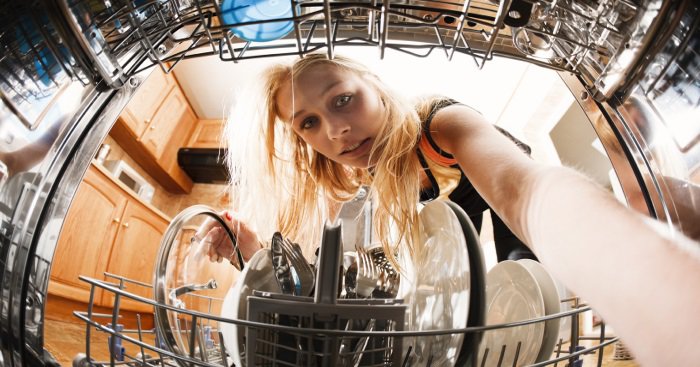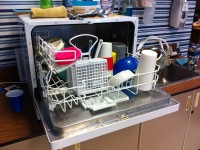Cleaning a dishwasher might seem like one of the most ridiculous things ever, as it’s the device that’s supposed to clean other things itself. But believe me, I’m not a crazy person to suggest that you should clean your helper, even though it’s exactly what a crazy person would say. Surely, you don’t have to bother maintaining a dishwasher nice and clean. It should wash itself along with the dishes, shouldn’t it? Well, while dishwashers don’t get too dirty or greasy, they still require occasional cleanings. Some debris gets stuck in the dishwasher’s corners and around the drain. The rack might lose its shininess; the utensil holder might accumulate the food crumbs. If your dishwasher is installed close enough to the stove or just counters you use as your kitchen working area, the grease, food pieces and liquid spills might get into the dishwasher and subside on the outside and inner side of the dishwasher’s door. Finger prints and water drops on the dishwasher’s exterior are the least difficult mess to clean up, even though you have to deal with them more often than with the throughout cleaning. On the other hand, getting rid of rust and mineral stains is the hardest part of the dishwasher cleaning process. Nevertheless, we’re going to learn how to do that, just as how to clean the entire dishwasher from head to toe.
How to clean a dishwasher
- Start cleaning a dishwasher just after it has completed a cycle. Take everything out of the dishwasher. Remove the dish racks and utensil baskets too. Otherwise, it will be not quite convenient to clean the machine’s tub.
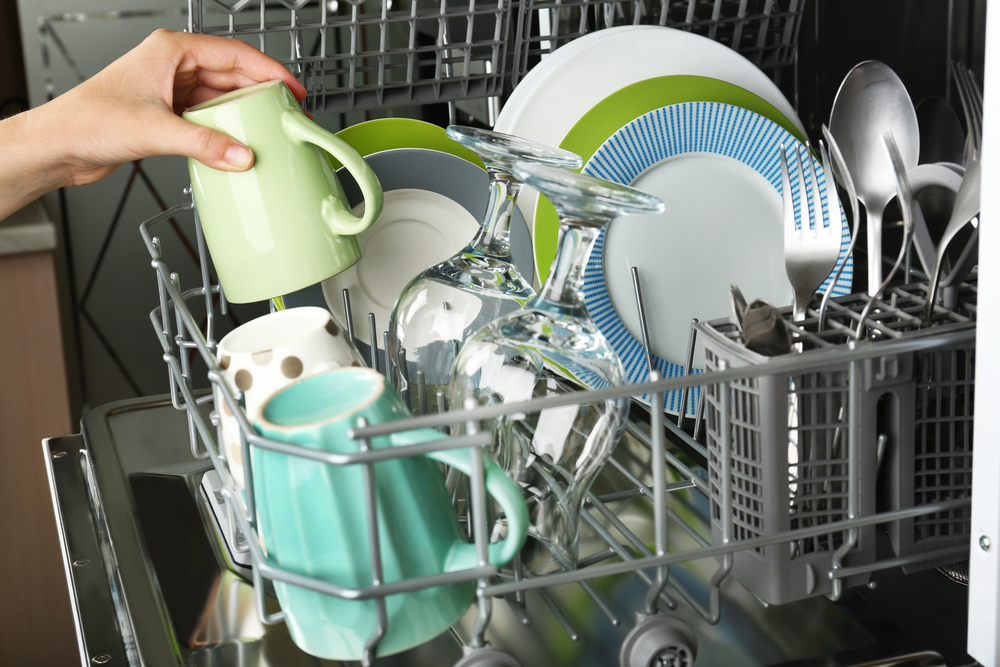
- Clean the dishwasher’s door to get rid of any stains, drop marks and fingerprints. To do that, get a soft sponge or microfiber rag. Then, you may soak your tool in plain warm water or prepare a baking soda and water cleaning solution. Either way, you should start the process by wiping the door on the outside. Avoid using too harsh sponges, scrapers and cleaning solutions not to damage the door and get it scratched. Once you’re finished cleaning the door, dry it with a soft towel and proceed to the door’s inside. Prepare a little bowl of warm water and dishwashing soap mix and find an old toothbrush. Vinegar and lemon juice mix should work great too. Open the door of your machine and treat its edges, the grooves of its rubber seal, other gaps and hinges using the supplies listed above. If you feel like you need to scrub, use a semi-abrasive cleanser. Be gentle while scrubbing not to damage the dishwasher’s surface and rubber structure of the seal. After that, go over the door’s inside with a sponge, soaked in warm soapy water. Wash the parts you’ve just cleaned using a damp cloth to get rid of the cleaning solution residue.
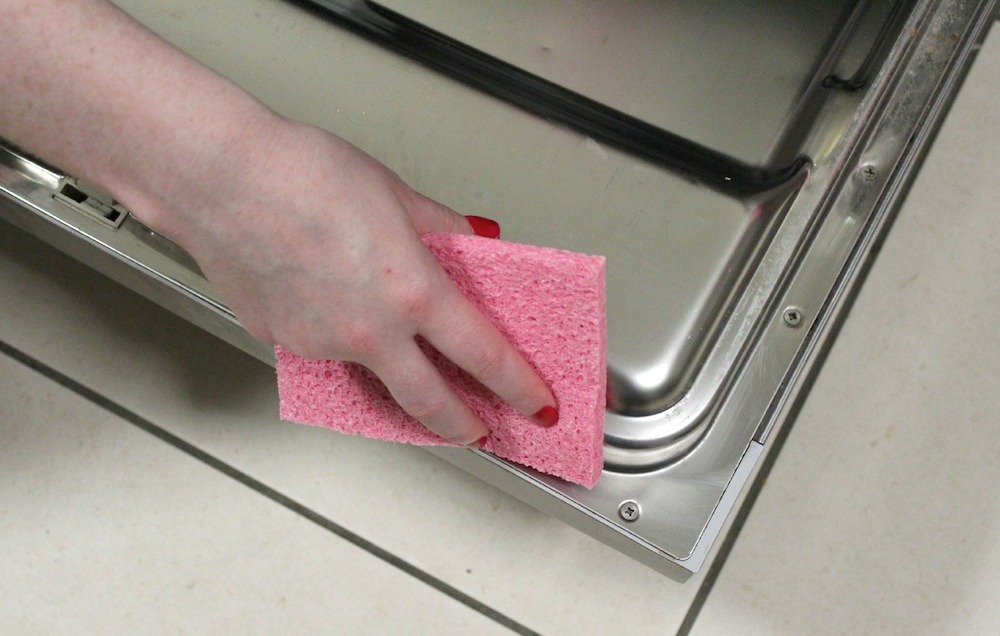
- Check the dishwasher’s spinning arms. They have a couple of holes on both ends, which have to be completely clean. The water should be able to run through them freely. Clear out the holes by removing any debris that has chocked them up. Use a toothpick or a similar tool. Be careful not to leave any scratches. Take a clean damp cloth to wipe along the entire length of the spinning arms.
- Clean underneath the machine’s door. The design of some dishwashers doesn’t allow water to get into this spot. Thus, food pieces and other debris may easily build up there. Examine the bottom of your dishwasher and clean it thoroughly with a sudsy sponge. Take an attentive look at the drain – the water exit right under the spinning arms. You’ll notice something like a grate around it. It’s usually clogged with various debris and calcium deposit. You need to get rid of all that stuff. Use a handy toothbrush or a toothpick for that matter. Disassemble a filter (if you have one) and clean its details with the help of a handy toothbrush, baking soda paste and warm soapy water. Check out Doityourself.com to get more detailed instructions on cleaning the dishwasher’s filter. Wipe down the remnants of the cleaning solution using a slightly damp sponge. Wipe around the dishwasher’s drain too. Make sure to remove all food crumbs and pieces of damp paper (stickers from cups, jars and plastic containers).
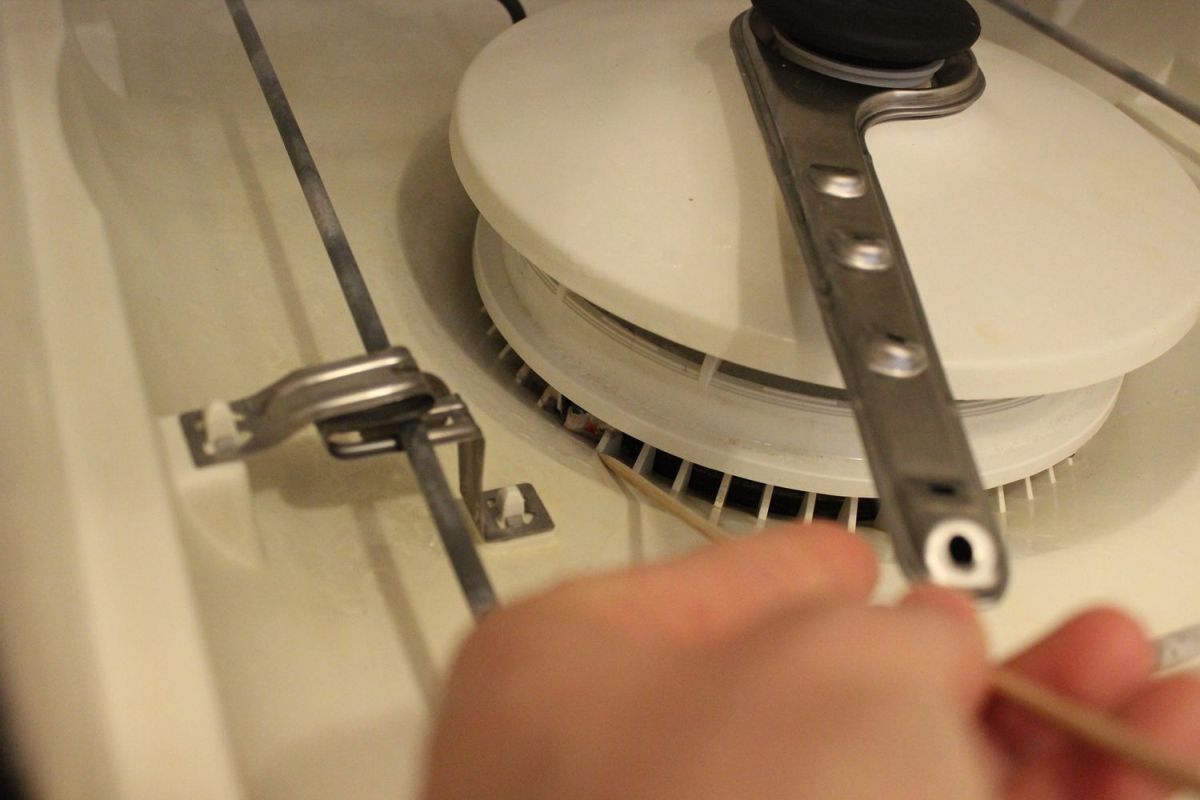
- Take care of racks and utensil holders. Make sure to get out all food pieces and other debris. Get rid of the dishwasher soap residue with the help of a toothbrush, warm soapy water and sponge. If these dishwasher accessories are too dirty and sticky, you may fill the sink with warm water, add a couple of drops of dish soap and leave them to soak in the sink overnight.
- Inspect your dishwasher to see if there’re any sighs of the hard water stains or ugly rust. If there’s such problem, you have to purchase the rust and mineral stains removing cleanser. Fill the soap dispenser of your machine with it, add a little bit of product to the machine’s bottom and start a completely empty dishwasher. Let it finish a full cycle on the average temperature settings if the cleanser’s instructions don’t require a different approach.

If you notice that those stains appearing on a regular basis, you should consider installing a water filter underneath your sink to avoid major dishwasher damages. Hard water is damaging not only to the dishwasher’s finish. It also leaves those ugly white marks on glasses and dishes. Moreover, there’re a lot of studies that prove its negative effects on human body. However, dishwasher and sink are often connected to the same pipe line. So, if you install a proper water softener and filter, you’ll end up with safer water both for you and your dishwasher. You may find quite detailed water softener installation instructions online and attach it to the pipes under the sink on your own. But, I’d highly recommend you to hire a plumber to deal with this task, as inexperienced person shouldn’t mess with the pipe lines not to cause more significant problems. So, visit HireRush.com to post a water filter/softener installation task for a plumber to let the local professionals receive your job requirement and reach out to you to get hired. Or, you may contact a plumber yourself by calling him directly from the website.Post a task for a plumber - Run an empty dishwasher. If you don’t have any calcium stains or rust on the dishwasher’s tub, you may finish the cleaning process by reinstalling the racks and utensil basket, placing a dishwasher safe cup with plain vinegar on the highest dish rack of the machine, choosing the hottest water setting and letting your empty machine run a full cycle.
